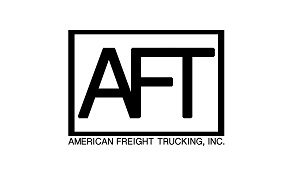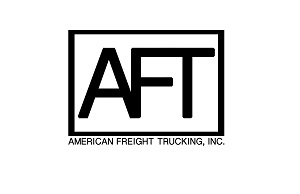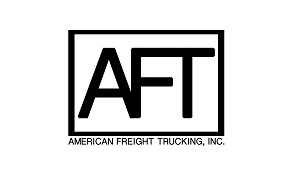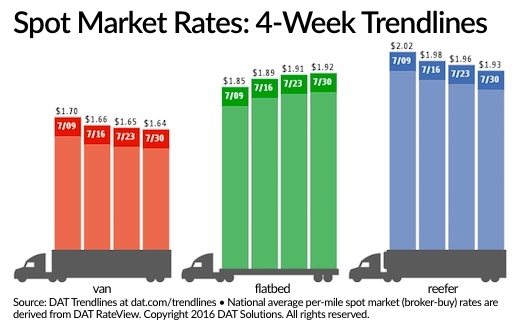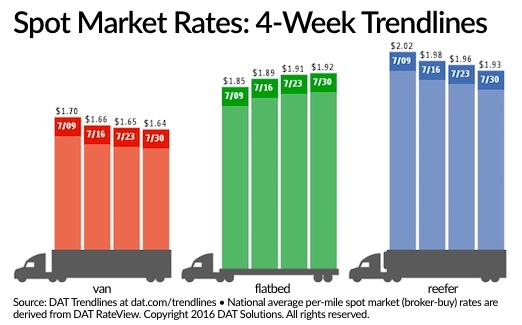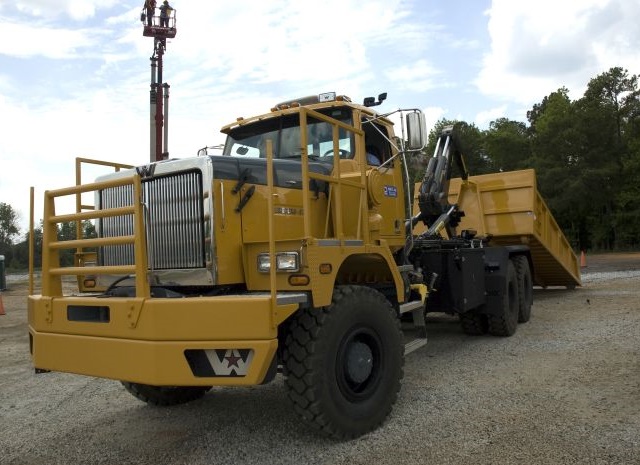<img width="150" src="http://www.automotive-fleet.com/fc_images/articles/m-heavyhauler3-1.jpg" border="0" alt="
Western Star's new 6900XD, hooked to a SmithCo 70-ton side dump trailer. Photos: John G. Smith
">
Western Star's new 6900XD, hooked to a SmithCo 70-ton side dump trailer. Photos: John G. Smith
">Not all heavy trucks travel on the highways, and that's why we were there when Western Star launched its head-turning 6900XD with the MBT-40 option.
The 6900 has been around for a long time. That doesn't mean it's old; it's been a work in progress all that time. The new XD (extreme duty) version the company brought to Michelin's Laurens, S.C., proving grounds for this demonstration represents the pinnacle of that evolution. While the truck is remarkable enough, Western Star has also developed a package that offers the customer unmatched versatility, called MBT-40. That stands for Multi Body Transformer, and it literally gives the customer several trucks for the price of one.
The truck can be engineered for on-road operations as well as different off-road applications. We drove the off-road version, engineered specifically for extremely rugged environments – in this case, mining operations. Even within that sphere, Western Star offers configurations for long-and short-haul operations. Long-haul is defined as anything in excess of 12 miles. In mining, you're moving earth and ore around a mine site or you're hauling it up out of a pit. The specs are quite different, and they include changes to the tires, brakes and powertrain.
For example, this truck had dry drum brakes, akin to what we find on a highway truck only bigger, as opposed to a wet-disc brake system. These systems are better suited for long steep grades with GVW in excess of 150,000 pounds. They also produce more mechanical drag when they are not applied, so fuel efficiency can be a concern. A Western Star brochure claims the truck configured as we drove it would consume about 7 gallons of fuel per hour, which is about the same as a highway truck averaging 8 mpg.
The truck also has high-pressure tires (145 psi) for reduced rolling resistance as opposed to softer tires designed for superior traction.
The powertrain is not for the faint-hearted. Western Star offers four engines, the DD15, DD16, Detroit Series 60 (until the end of 2017) and the Cummins ISX in ratings up to 600 hp and 1,850 lb-ft.
“The Tier III-compliant 505-hp Series 60 is a new engine, not a reman,” says John Tomlinson, XD and vocational sales manager for Western Star. “It's available through special arrangements Daimler negotiated with EPA quite a few years ago. The DD15 and 16 are EPA 2017 compliant. We bypassed Tier IV and went right to EPA 17.”

The basic chassis is available in 6x4, 6x6 or 8x8 twin-steer (all-wheel drive), which demands a transfer case and often an auxiliary transmission (such as the 3-speed Fabco FAT-30), in addition to the 7-speed Allison 4700 RDS or ORS (Off Road Series) automatic transmissions.
Axle-wise, the 6900XD features planetary axles with a final drive ratio of 11.26:1. Compare that to a downsped highway truck with a ratio of perhaps 2.4 or 2.26:1. The truck configured as we drove it had a top speed of 43 mph, but it can do that up and down hills and on flat ground all day long.
Depending on the exact spec and the trailer you might be pulling with it, the standard configuration gives you a capacity of 40 metric tons, with an option of going to 100 metric tons. If you go all out and use a heavy-haul trailer with the correct fifth wheel rating, pulling capacity can soar to 180 tons.

The MBT option
The MBT-40, dubbed the Multi-Body Transformer for its ability to quickly change from one fully functional cab-controlled body application to another, is a new concept for off-road equipment markets. The MBT-40 package allows customers to go, for example, from a 70-ton tip tractor (like the one we drove) to a 35-ton dump body to an 8,000-gallon water tank in a matter of minutes.
The MBT-40 uses a 68,000-lb Palfinger G68 hook-lift to hoist the various bodies up onto the frame, much the same way a roll-off truck works. The in-cab control system and the self-adapting onboard hydraulics package automatically determine which body has been dragged aboard and assigns the controls accordingly. All the operator has to do is hook up the control and actuator lines and drive away.
It is designed to replace the need for multiple pieces of dedicated off-road equipment on a job site that sit for long periods of time when they are not needed, says Tomlinson.
“The MBT-40 package is a game changer in construction applications for its ability to be multiple pieces of equipment in one chassis,” he said. “The development of this platform was all about finding better economic ways of filling needs for our customers. Off-road chassis equipment can be expensive to buy and maintain, and new emissions levels are making the investment even more costly.”
Engineers from several truck body manufacturers came together to design and test their equipment on the XD chassis, including Carco Industries, Klein Products, Ground Force, SmithCo and Palfinger. All had to make some design changes to their typical configurations to accommodate the quick-hookup electrical and hydraulic connections, and to accommodate the lift mechanism. Word from the field is they are very happy with the opportunities the MBT concept offers and are reportedly busy working on more body configurations to suit equipment in other applications.
WATCH: Focus On... Western Star's MBT-40 [Video]

On the trail
The last thing they told me before I put the truck into gear and drove off was, “It takes a few acres to turn the thing around.” Knowledge gained from previous experience pulling trains told me I had to be sure I had a way out before nosing in somewhere that I couldn't turn around. Hence, I went straight when I should have turned right because I could see the path ahead. Not knowing the path ahead led to the off-road section of the proving ground, I blithely drove on through the windy and hilly dirt road they had been running the dump trucks on all day. There were some very tight turns and a few hillocks I feared I might bottom-out the trailer, but I soldiered on.
Unknown to me, there was a bunch of head-slapping and eye-rolling going on behind me in the gallery where my colleagues sought refuge from the South Carolina sun. What the event officials neglected to tell me was the tractor-trailer setup was supposed to stay on the gravel road.
I have pulled 140,000-lb loads off road before, back in my real driving days, and with much less truck than the 6900XD, so I wasn't the least bit concerned. The 500-hp DD16 was churning out all the torque I needed, and the Allison was bouncing around between 2nd and 3rd gear like a day in the park.
With the big steel front fenders and steel railings out front, it felt a little like sitting in a locomotive — though on the wrong side of the cab. It was a rough ride to be sure. My camera man, John G. Smith of Today's Trucking, did his best to keep the camera pointed my way, and he mostly succeeded. Rough though it was, it was manageable. And it was really quiet in the cab as well.

On a few occasions, the ground turned from a 2- or 3-inch-deep layer of dust over a firm surface, to a morass of soft, talc-like dust at least a few feet deep, replete with tire ruts from previous passes of the dump trucks. Again, my 140,000-lb 6900XD just dug in and got the job done. I stopped at one point to retrieve a GoPro camera that had been tossed off the truck by a particularly nasty bump. Everyone back in the gallery believed I had become stuck.
Not a chance. I found the camera, stuffed it back into gear and plowed back through the dirt heading for the shelter.
Later, Kelley Platt, the president of Western Star, told me she was very pleased that I had taken the truck off-road, though she admitted I was in uncharted territory and they were all holding their breath waiting to see if I would make it out.
I had little doubt the mission would be a success. With six wheels driving there's tons of traction and more than enough power to keep everything moving.
Earlier in the day Platt put a smile on a few journalists' faces by calling the 6900XD a “kick-ass truck.” I couldn't agree with her more.
Related: Western Star Debuts Extreme Duty Off-Road 'Transformer'
Follow @HDTrucking on Twitter

